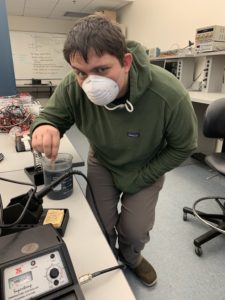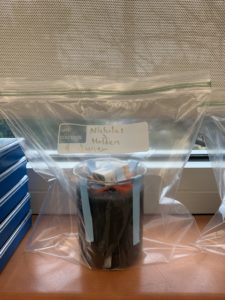Week 5
Javier and Nicholas J. Holden
This week was spent focused on collecting and reconstructing the data. Luckily, our machine appeared to be functioning correctly, and no adjustments were needed to the machine.
We decided to collect data in two ways: two sweeps with our servo while our stepper is rotating at 60rpm and then one sweep with the servo. When there’s two sweeps, the ctRecon template image looks like a mirror image. Instead of trying to do some fancy math, we decided to collect the data in the two prescribed ways. It makes the math and future reconstruction a little easier.
We also changed the phantom to ensure that our code was running accurately and the data collected was changing with each phantom. Unfortunately, we experienced an issue with our servo / arm in that it could not move backward on the metal arm overhang. This meant we were not allowed to photo larger phantoms because there physically wasn’t enough space. The issue appeared to be that the person who configured the metal arm had hammered in a nut to a bolt and NOT a slider. Such brute force resulted in the slider unable to move backward. After an annoyed sigh, we decided to replace the phantom with a smaller one. While running the program on the replacement phantom, we made our own homemade auger phantom. To ensure we were protected from the graphite particulates and the Coronavirus, we wore masks.
After microwaving the mixture, we had to continually stir it and wait for the temperature to decrease. Figure 1 illustrates this action by Javier. It was imperative that the two substances didn’t separate. We decided to create a bucket of ice to place the mixture in because we needed the auger/graphite mixture to reach a low enough temperature; this was important because we wanted to stop stirring while ensuring that there was minimal separation with the graphite and auger powder. As seen in Figure 2, we McGuyver’d the contraption. A dead battery was placed on top of the phantom in an effort to submerge it more into the liquid mixture. Afterwards, we placed tape everywhere and left it in a bag. We are excited to see what will happen to our device next week.
 Figure 1 – Javier stirring the graphite/auger mixture
Figure 1 – Javier stirring the graphite/auger mixture

Figure 2 – The graphite/auger mixture inside a bag. The white dead battery is visible on top of the orange phantom that was submerged into the liquid
Question: The servo has an extra (white) wire on it, that reads out its built-in position potentiometer, which you can use to record the servo’s actual position (rather than just its intended position). Is your image reconstruction improved by using this value instead of the intended value?
Answer: This would provide a more accurate measure of the servo angle but would require making sure that the servo is actually hitting all the positions in order to form the image. This may happen if there is something wrong with the servo and it is actually not hitting the right positions and would be visible with potentiometer voltages.
